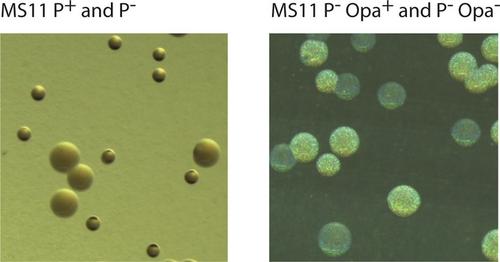Genetic Manipulation of Neisseria gonorrhoeae and Commensal Neisseria Species
Joseph P. Dillard, Jia Mun Chan
{"title":"Genetic Manipulation of Neisseria gonorrhoeae and Commensal Neisseria Species","authors":"Joseph P. Dillard, Jia Mun Chan","doi":"10.1002/cpz1.70000","DOIUrl":null,"url":null,"abstract":"<p>The sexually transmitted pathogen, <i>Neisseria gonorrhoeae</i>, undergoes natural transformation at high frequency. This property has led to the rapid dissemination of antibiotic resistance markers and the panmictic structure of the gonococcal population. However, high-frequency transformation also makes <i>N. gonorrhoeae</i> one of the easiest bacterial species to manipulate genetically in the laboratory. Techniques have been developed that result in transformation frequencies >50%, allowing the identification of mutants by screening and without selection. Constructs have been created to take advantage of this high-frequency transformation, facilitating genetic mutation, complementation, and heterologous gene expression. Similar methods have been developed for <i>N. meningitidis</i> and nonpathogenic <i>Neisseria</i> including <i>N. mucosa</i> and <i>N. musculi</i>. Techniques are described for genetic manipulation of <i>N. gonorrhoeae</i> and commensal <i>Neisseria</i> species, as well as for growth of these fastidious organisms. © 2024 The Author(s). Current Protocols published by Wiley Periodicals LLC.</p><p><b>Basic Protocol 1</b>: Spot transformation of <i>Neisseria gonorrhoeae</i> on agar plates</p><p><b>Basic Protocol 2</b>: Spot transformation of commensal <i>Neisseria</i> on agar plates</p><p><b>Basic Protocol 3</b>: Transformation of <i>Neisseria gonorrhoeae</i> in liquid culture</p><p><b>Basic Protocol 4</b>: Electroporation of <i>Neisseria gonorrhoeae</i></p><p><b>Basic Protocol 5</b>: Creation of unmarked mutations using a positive and negative selection cassette</p><p><b>Basic Protocol 6</b>: In vitro mutagenesis of <i>Neisseria gonorrhoeae</i> chromosomal DNA using EZ-Tn5</p><p><b>Basic Protocol 7</b>: Chemical mutagenesis</p><p><b>Basic Protocol 8</b>: Complementation on the <i>Neisseria gonorrhoeae</i> chromosome</p><p><b>Alternate Protocol 1</b>: Complementation with replicating plasmids</p><p><b>Alternate Protocol 2</b>: Complementation on the <i>Neisseria musculi</i> or <i>Neisseria mucosa</i> chromosome</p><p><b>Basic Protocol 9</b>: Preparation of chromosomal DNA from <i>Neisseria gonorrhoeae</i> grown on solid medium</p><p><b>Alternate Protocol 3</b>: Preparation of chromosomal DNA from <i>Neisseria gonorrhoeae</i> grown in broth</p><p><b>Support Protocol</b>: Preparing PCR templates from <i>Neisseria gonorrhoeae</i> colonies</p>","PeriodicalId":93970,"journal":{"name":"Current protocols","volume":"4 9","pages":""},"PeriodicalIF":0.0000,"publicationDate":"2024-09-04","publicationTypes":"Journal Article","fieldsOfStudy":null,"isOpenAccess":false,"openAccessPdf":"https://onlinelibrary.wiley.com/doi/epdf/10.1002/cpz1.70000","citationCount":"0","resultStr":null,"platform":"Semanticscholar","paperid":null,"PeriodicalName":"Current protocols","FirstCategoryId":"1085","ListUrlMain":"https://onlinelibrary.wiley.com/doi/10.1002/cpz1.70000","RegionNum":0,"RegionCategory":null,"ArticlePicture":[],"TitleCN":null,"AbstractTextCN":null,"PMCID":null,"EPubDate":"","PubModel":"","JCR":"","JCRName":"","Score":null,"Total":0}
引用次数: 0
Abstract
The sexually transmitted pathogen, Neisseria gonorrhoeae, undergoes natural transformation at high frequency. This property has led to the rapid dissemination of antibiotic resistance markers and the panmictic structure of the gonococcal population. However, high-frequency transformation also makes N. gonorrhoeae one of the easiest bacterial species to manipulate genetically in the laboratory. Techniques have been developed that result in transformation frequencies >50%, allowing the identification of mutants by screening and without selection. Constructs have been created to take advantage of this high-frequency transformation, facilitating genetic mutation, complementation, and heterologous gene expression. Similar methods have been developed for N. meningitidis and nonpathogenic Neisseria including N. mucosa and N. musculi. Techniques are described for genetic manipulation of N. gonorrhoeae and commensal Neisseria species, as well as for growth of these fastidious organisms. © 2024 The Author(s). Current Protocols published by Wiley Periodicals LLC.
Basic Protocol 1: Spot transformation of Neisseria gonorrhoeae on agar plates
Basic Protocol 2: Spot transformation of commensal Neisseria on agar plates
Basic Protocol 3: Transformation of Neisseria gonorrhoeae in liquid culture
Basic Protocol 4: Electroporation of Neisseria gonorrhoeae
Basic Protocol 5: Creation of unmarked mutations using a positive and negative selection cassette
Basic Protocol 6: In vitro mutagenesis of Neisseria gonorrhoeae chromosomal DNA using EZ-Tn5
Basic Protocol 7: Chemical mutagenesis
Basic Protocol 8: Complementation on the Neisseria gonorrhoeae chromosome
Alternate Protocol 1: Complementation with replicating plasmids
Alternate Protocol 2: Complementation on the Neisseria musculi or Neisseria mucosa chromosome
Basic Protocol 9: Preparation of chromosomal DNA from Neisseria gonorrhoeae grown on solid medium
Alternate Protocol 3: Preparation of chromosomal DNA from Neisseria gonorrhoeae grown in broth
Support Protocol: Preparing PCR templates from Neisseria gonorrhoeae colonies

淋病奈瑟菌和共生奈瑟菌种的基因操作。
性传播病原体淋病奈瑟菌(Neisseria gonorrhoeae)会频繁发生自然转化。这一特性导致抗生素耐药性标记的快速传播和淋球菌种群的泛杀性结构。然而,高频转化也使淋球菌成为实验室中最容易进行基因操作的细菌物种之一。目前已开发出转化率大于 50% 的技术,可以通过筛选鉴定突变体,而无需选择。利用这种高频率转化的优势,构建体得以产生,从而促进了基因突变、互补和异源基因表达。针对脑膜炎奈瑟菌和非致病性奈瑟菌(包括粘膜奈瑟菌和蕈样奈瑟菌)也开发了类似的方法。此外,还介绍了淋病奈瑟菌和共生奈瑟菌的基因操作技术,以及这些致病性微生物的生长技术。© 2024 作者。当前协议》由 Wiley Periodicals LLC 出版。基本方案 1:淋病奈瑟菌在琼脂平板上的点滴转化 基本方案 2:共生奈瑟菌在琼脂平板上的点滴转化 基本方案 3:淋病奈瑟菌在液体培养物中的转化 基本方案 4:淋病奈瑟菌的电穿孔 基本方案 5:使用正负选择盒产生无标记突变 基本方案 6:使用 EZ-Tn5 对淋病奈瑟菌染色体 DNA 进行体外诱变 基本方案 7:基本方案 8:在淋病奈瑟菌染色体上进行互补 替代方案 1:用复制质粒进行互补 替代方案 2:在蕈样奈瑟菌或粘膜奈瑟菌染色体上进行互补 基本方案 9:从生长在固体培养基上的淋病奈瑟菌中制备染色体 DNA 替代方案 3:从生长在肉汤中的淋病奈瑟菌中制备染色体 DNA 支持方案:从淋病奈瑟菌菌落中制备 PCR 模板。
本文章由计算机程序翻译,如有差异,请以英文原文为准。


